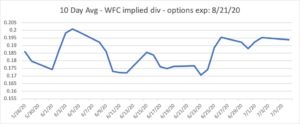On June 25th, the Federal Reserve released results of its 2020 stress test for banks. New guidelines were published forcing banks to halt buybacks and reduce dividend payouts. As a result, Wells Fargo (WFC) will have to cut its dividend, but by precisely how much?
The bank will give its answer on July 14, along with company earnings on July 14. Sell-side analysts have come forth with their forecasts regarding the reduction. However, many of their approaches rely on income statements and several growth assumptions. Our quantitative approach to this problem cuts out the guesswork and relies on expectations priced in the options market.
Quoted option prices embed information about the stream of future underlying dividend payments. A common back-of-the-envelope estimation for dividends applies the put-call parity formula, which is an arbitrage relationship between puts and calls. This method is pretty reasonable for European options; but single name options are primarily American. The same arbitrage restrictions do not hold, leading to biased and incorrect results.
We take the sophistication up a notch and solve for dividends in binomial trees calculations. This technique accounts for the early exercise found in American options, which allows for more accurate estimates.
The graph below represents a 10-day rolling average of the WFC implied dividend for options expiring on August 21, 2020. We use a rolling calculation to smooth out noise from varying bid/ask spreads. The market expectation is pricing in a dividend of approximately 20 cents, or a decrease of 60%. In yield terms, the annual yield falls to 3.3% from 8.3%.
Source: OptionMetrics
This cut is substantially larger than sell-side analyst predictions from Raymond James (-31% cut) and J.P. Morgan (between 25% and 50%). Interestingly, the market had already priced this cut long before the results of the stress tests were revealed. At the end of May, options were readily expecting a reduced Q3 dividend between 17 and 20 cents. In other words, the news of the Fed’s new capital restriction had made a lot noise—but the market had known long before a dividend change needed to happen for WFC.
